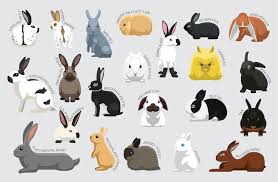Rabbits are classified into small, medium, large, or giant breeds based on their body weight. There are various breeds that fall within these broad classifications. Some of these breeds are described in this article, allowing identification and selection of the breed that best meets production objectives.
Classification of Rabbits by Body Size
1. Small Breeds: 0.9-2.7 kg
2. Medium Breeds: 2.7-4.1 kg
3. Large Breeds: 4.1-5 kg
4. Giant Breeds: 5 kg and above
Read Also: 15 Medicinal Health Benefits Of Aspidosperma quebracho-blanco (Quebracho Blanco)
Major Breeds of Rabbits for Agricultural Production

1. California Breed: This breed is the second most popular for meat production. The coat is all white with black tipping on the nose, ears, feet, and tail. The mature weight for the Californian breed ranges from 3 to 4.5 kg.
2. New Zealand White: The New Zealand White is the most widely used breed for meat production globally. It is all white in color and typically weighs between 3 and 5 kg at maturity.
4. American Chinchilla: This breed has a blue-grey color with a white belly and a distinctive ruff or dewlap (a thick fold of skin around the chest). The mature weight for the American Chinchilla ranges from 3 to 4.5 kg.
5. Dutch Breed: The Dutch is a small breed, with a mature live weight of 2.5 to 3.5 kg. It has a wide white band of fur around its shoulders and a white stripe down the middle of its face. Its front feet are white, with white tips on the back feet.
Read Also: 10 Medicinal Health Benefits Of Astrocaryum aculeatissimum (Tucum)
6. Flemish Giant: A giant breed, the Flemish Giant can weigh over 6 kg at maturity. It is typically light grey but may also be found in sandy, blue, or white variations. This breed is not recommended for beginners.

7. New Zealand Red: The New Zealand Red is similar to the white New Zealand breed but has not been as intensely selected for growth rate. The mature live weight is lower, typically ranging from 3 to 4.5 kg.
8. English Spot: The mature weight of the English Spot ranges from 2.3 to 3.6 kg. This breed comes in a variety of colors, including black, blue, chocolate, gold, gray, lilac, and tortoise. It is primarily white with a butterfly mark on the nose, colored ears, eye circles, and a chain of colored spots along its sides, including a herringbone stripe down its back.
9. Lops: Lops are recognized for their distinctive long, floppy ears. The five types generally accepted in the USA include: French Lop, English Lop, Mini Lop, American Fuzzy Lop, and Holland Lop. The French Lop’s ears are shorter than those of the English Lop, and it weighs around 5 to 5.5 kg at maturity.
10. Dwarf Breeds: Dwarf rabbits are very small, with an average litter size of two to four, as opposed to the larger breeds which have 6 to 12 bunnies. These rabbits are more susceptible to coccidiosis, an intestinal parasite that can prove fatal to young rabbits between three and ten weeks of age.
After learning about the different classifications and breeds of rabbits, it is clear that there is no single “best” breed. Breeders should select the breed that best fits their specific production objectives.
Do you have any questions, suggestions, or contributions? If so, please feel free to use the comment box below to share your thoughts. We also encourage you to kindly share this information with others who might benefit from it. Since we can’t reach everyone at once, we truly appreciate your help in spreading the word. Thank you so much for your support and for sharing!
Frequently Asked Questions
We will update this section soon.

